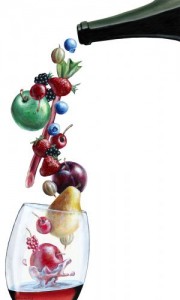
A great article by Amy Thielen of the Star Tribune. Makes me want to drive down to Minnesota and do a little fruit wine touring…
The taste of northern Minnesota comes through in the fruit flavors of Forestedge Winery, just as you can divine the story of the land, or the “terroir,” in a good French Burgundy, a glass of Minnesota fruit wine tells the story of this area: its caches of wild fruit, its early inhabitants, its new arrivals, its windfalls and deprivations all coming together in a sweet, powerful liquid.
As is the case with many food traditions in the Midwest, someone is currently bringing a new level of sophistication to this one. People have always made wines from the fruit that grows naturally here, although in my experience some of them have been more “Whoa, that’s strong!” than “Holy cow! Delicious!”
Although it’s often difficult for home winemakers to bring flavor and alcohol production into balance, recently some commercial producers of fruit wines have achieved a high level of consistent technical skill.
If the glut of nongrape wines entering the Minnesota State Fair is any indication, we finally have some fruit wines good enough to challenge the supremacy of the grape. No doubt, grape wines can express quirks of flavor as dramatically as the best of them, but nothing says home like wine brewed from the fruit at your feet.
Fruit wineries have cropped up statewide, some also making wine from cold-hardy grapes developed at the University of Minnesota. Others, such as Forestedge Winery near Laporte, Minn., one of the state’s northernmost wineries, shun the grape altogether.
“So much of what we do still has an anchor in the basement,” said Paul Shuster, who is co-owner of Forestedge with his wife, Sharon, and their friend John Wildmo.
That is, even though they’ve won enough wine contest awards to choke a fireplace mantel and now make 35,000 bottles a year, they continue to ferment each of the many fruit wines they make in 35-gallon barrels — which means that each batch numbers at least 50 barrels. They like to keep the process manageable, on a human scale.
“But it doesn’t make sense,” said Shuster. “We’re more comfortable working this way, but we have 50 barrels to clean after each batch.”
The operation may have begun in a root cellar, but their current facility gleams with stainless steel. It’s a Russian stacking doll of old and new: foraged wild berries inside a laboratory, inside a charming barn-red structure sitting next to one of the largest rhubarb fields I’ve ever seen.
To the west, you see plum trees and the raspberry plantation. They hire local pickers — mostly retired folks and professional foragers — to bring in the wild berries and fruits. All of the rhubarb for their signature rhubarb wine is grown on-site.
They moved to their land in the 1970s. There, on 40 acres between Walker and Park Rapids, Paul and Sharon began making wine from their rhubarb. Their early attempts used natural fermentation, which relies on microbes in the air to provide the yeast.
“Using just natural yeast, the wine only fermented to 6 percent alcohol. It was all sugar. When we poured it, within minutes, hundreds of wasps circled our glasses,” said Shuster.
A lesson in winemaking
Not long after that, they began to take their winemaking more seriously. Paul began splitting and transplanting the rhubarb plants from the family garden, and in the 1980s they planted a small field of chokecherry trees. Their Volkswagen mechanic, Wildmo, who initially partook of their fruit wines during a house call on the Shusters’ 1961 VW bus, caught the winemaking bug himself and eventually joined the venture.
As they neared opening, Sharon nailed down their formulas for making fruit wines in (relatively) large batches. Today, their winemaking process reads more like a science textbook than a back-to-the-land manual.
A bit of sweetener
Blueberry and strawberry don’t need much additional sugar, but a chokecherry wine might need just a bump. Delicate and flinty, not unlike a dry rosé, the chokecherry wine is used in Paul’s tasting room to introduce people to fruit wines.
Not only is chokecherry the most iconic of all fruit wines, but it’s also distinctive and singular, with a rose-hip hue and fleeting scents of basil and black pepper that come and go with progressive sips.
More than the others, its restraint seems to capture the lean beauty of our northern, boreal forest, and I like to drink it with cheeses, or before dinner — though I’ve also found it to match chicken and fish well.
Making our way down the row in the tasting room, I love the woodsy character of the black currant, which has the dark, leathery tone of an old Rioja and the acidity of a wild blackberry. The winemakers suggest drinking it with grilled meats, and immediately I think of a grilled Iowa chop.
The plum tastes exactly like an excellent Japanese plum wine of recent memory: potent, it lingers flirtatiously with ripe, musky fruit, and for me, suggests a dessert pairing. The apple, now made exclusively from Honeycrisp, tastes deeper than many of the small-batch apple wines I tasted during a trip to Germany a few years ago, and fairly begs for a bacon and onion tart for companionship.
Later that night, around the campfire, I poured everyone a tipple of the chokecherry. Our visitors from out-of-state were pleasantly surprised at its complexity, and I was secretly grateful for it, a tap into the culinary heart of our atypically beautiful, hardscrabble northern territory.
Amy Thielen is a chef and writer who divides her time between Two Inlets, Minn., and New York City.
